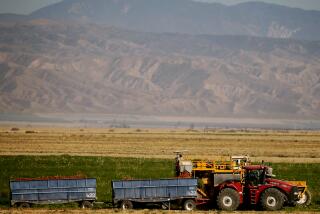In Back Rooms and Boardrooms, Water Wars Continue
- Share via
It’s been a year since the drought ended and we stopped worrying about the amount of water flowing from our faucets.
We’re back to long showers, multiple flushes and hosing off the patio and driveway. Despite our lack of concern, however, the threat of water rationing remains in the background, ready to surface during the next dry spell. California, particularly the Southland, depends on a complex, expensive and inadequate water supply system that is constantly under stress from rainless periods and steady urban population growth.
Politics as much as engineering shaped the system--politics responding to the needs of farmers, industrialists, land developers and California’s 30 million residents.
Although the engineering has never particularly interested me, I’m awed by the size of the two great dams that store water for the Southland--Oroville in far Northern California and Boulder, outside Las Vegas. But mostly I’m like everyone else, indifferent as long as they get the water to my house and don’t bore me with the details.
It’s the politics that are most fascinating, pitting powerful economic interests against each other in fierce and sometimes bloody combat. The movie “Chinatown” was based on the crooked land deals and violence spawned by the importation of water from the Owens Valley to Los Angeles. The titles of books written about California’s water wars reflect the intensity and high economic stakes--”Rivers of Empire,” “Dividing The Waters,” “The Great Thirst,” “Cadillac Desert.”
The wars continue today, although they are now waged in government meeting rooms, in bland, technical language that masks the importance of the debate.
*
The latest episode began on Monday, in a meeting room in the headquarters of the Metropolitan Water District of Southern California, which supplies water to Los Angeles, Orange, San Diego, Riverside, San Bernardino and Ventura counties.
Duane Georgeson, MWD assistant general manager, talked about the future. Georgeson is a quiet but forceful man who has fought to increase the region’s water supply, first as a top engineer with the Los Angeles Department of Water and Power and now with Metropolitan.
In an understated manner, he said that Gov. Pete Wilson’s water director, Dave Kennedy, was reducing MWD’s usual allocation from the State Water Project, which ships water from Oroville Dam through the Central Valley to Southern California. At the same time, Kennedy was increasing allocations to Central Valley water districts controlled by big agribusiness firms. Although nobody said so, these firms have been major political contributors to Republican gubernatorial campaigns.
To people in the water business, it was like Pearl Harbor. The Southern California Metropolitan Water District, wanting to secure a water source for the future, had paid for much of the construction of the expensive water project in the 1960s and Central Valley agribusiness had benefited from it.
MWD was once allied with agriculture in the effort to import water from Northern California. Its current opposition to big farmers is a sign of how California is changing from a state once dominated by agriculture to one where power rests with urban and suburban areas demanding more of the state’s limited water supply.
This shift in allegiances means Wilson will be confronted with tough choices when he runs for reelection next year, not from rank-and-file voters but from business people who depend on water for growth. Industrialists and developers in areas served by the MWD and Central Valley farm firms--all part of the Republican constituency--will press their conflicting demands upon the governor.
By Wednesday, the threat to Metropolitan’s northern water supply had increased even more.
The Clinton Administration announced plans to tighten the limits on the amount of water exported from the Sacramento-San Joaquin Delta. This may seem pretty distant, but it definitely affects our faucets.
As State Water Project water heads south from Oroville Dam, it passes through the delta--a huge collection of inlets and streams east of San Francisco Bay. Powerful pumps move the water south from the delta. The process has depleted the delta of fresh water, all but destroying a prime fishing ground. Under heavy pressure from environmentalists, the federal government moved to save the delta by reducing the amount of water available to Southern California and Central Valley farmers.
These limits would intensify the conflict between the urban and suburban Southland and farmers in the Central Valley.
*
Now, the Metropolitan Water District is in the middle of a tough campaign to preserve and expand the water supply for the 15.3 million people within its boundaries.
The issue will be background music in the forthcoming gubernatorial campaign. The headlines will go to the death penalty. But in the back rooms, where the big money people meet with the candidates, they will ask the politicians about water, the commodity needed to run plants and farms and support residential subdivisions.
The lesson of the week was clear: Politics, as much as droughts and engineering, will determine whether we can continue to be frequent bathers or must again submit to the rigors of water rationing.
More to Read
Sign up for Essential California
The most important California stories and recommendations in your inbox every morning.
You may occasionally receive promotional content from the Los Angeles Times.













